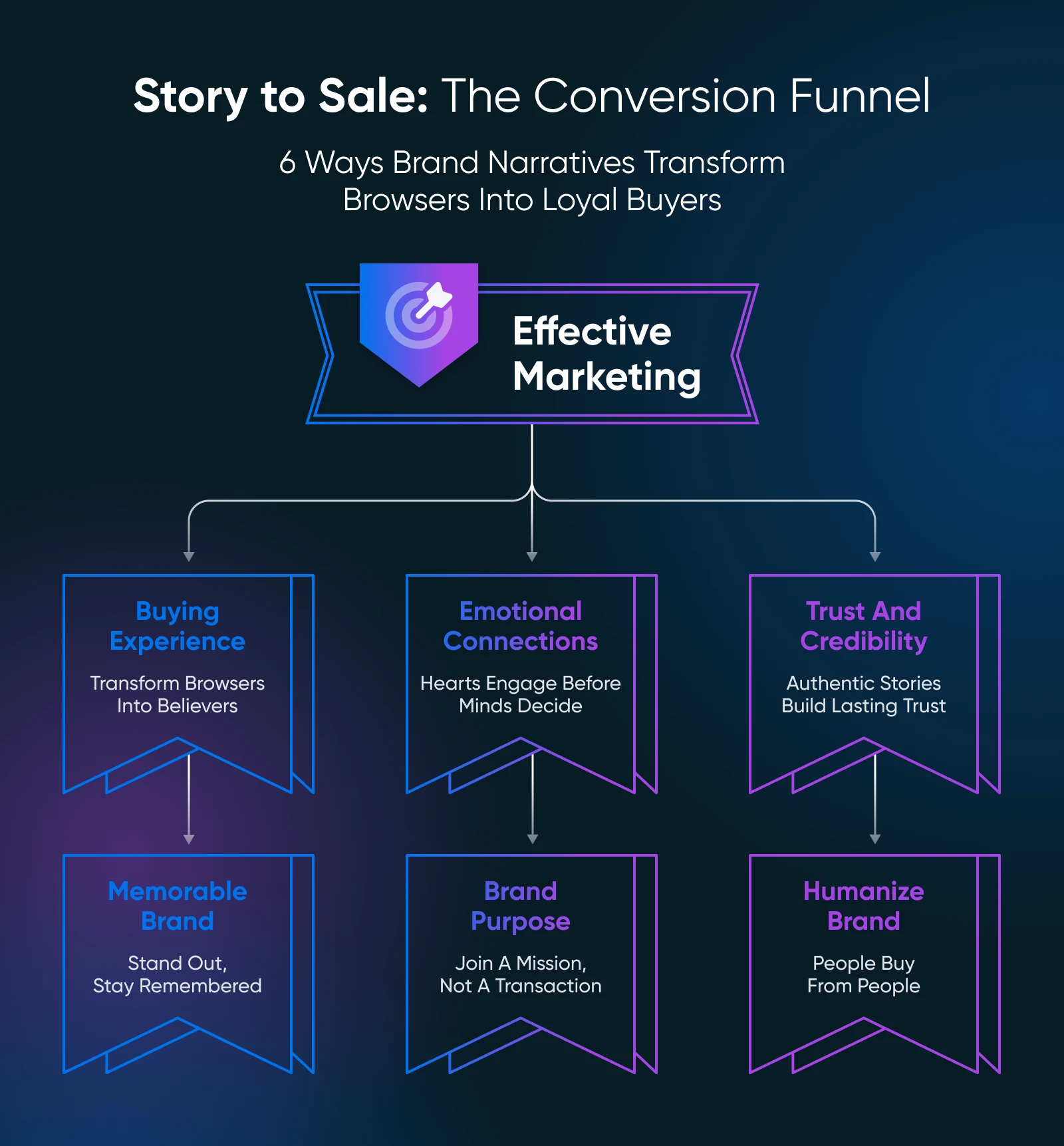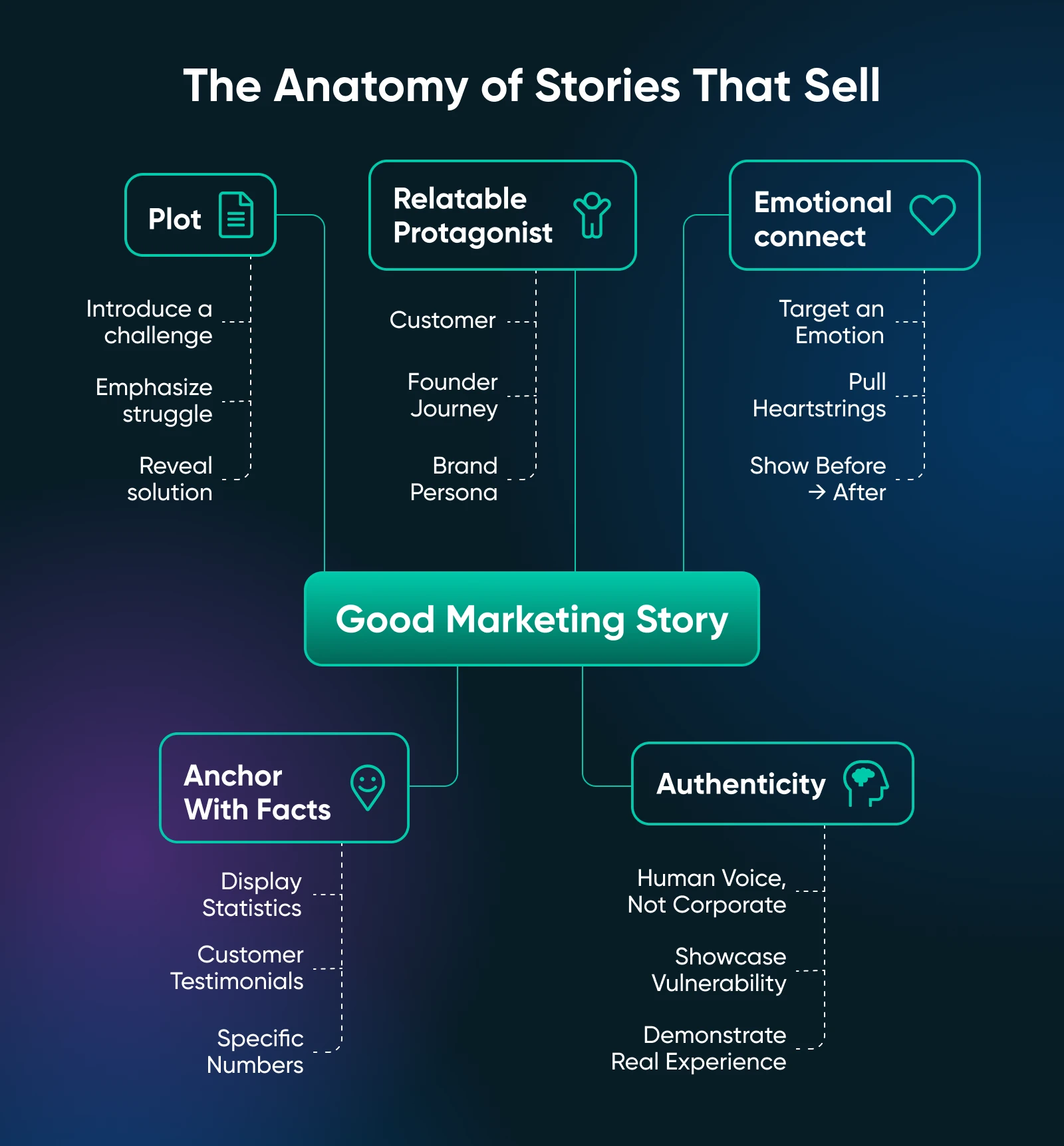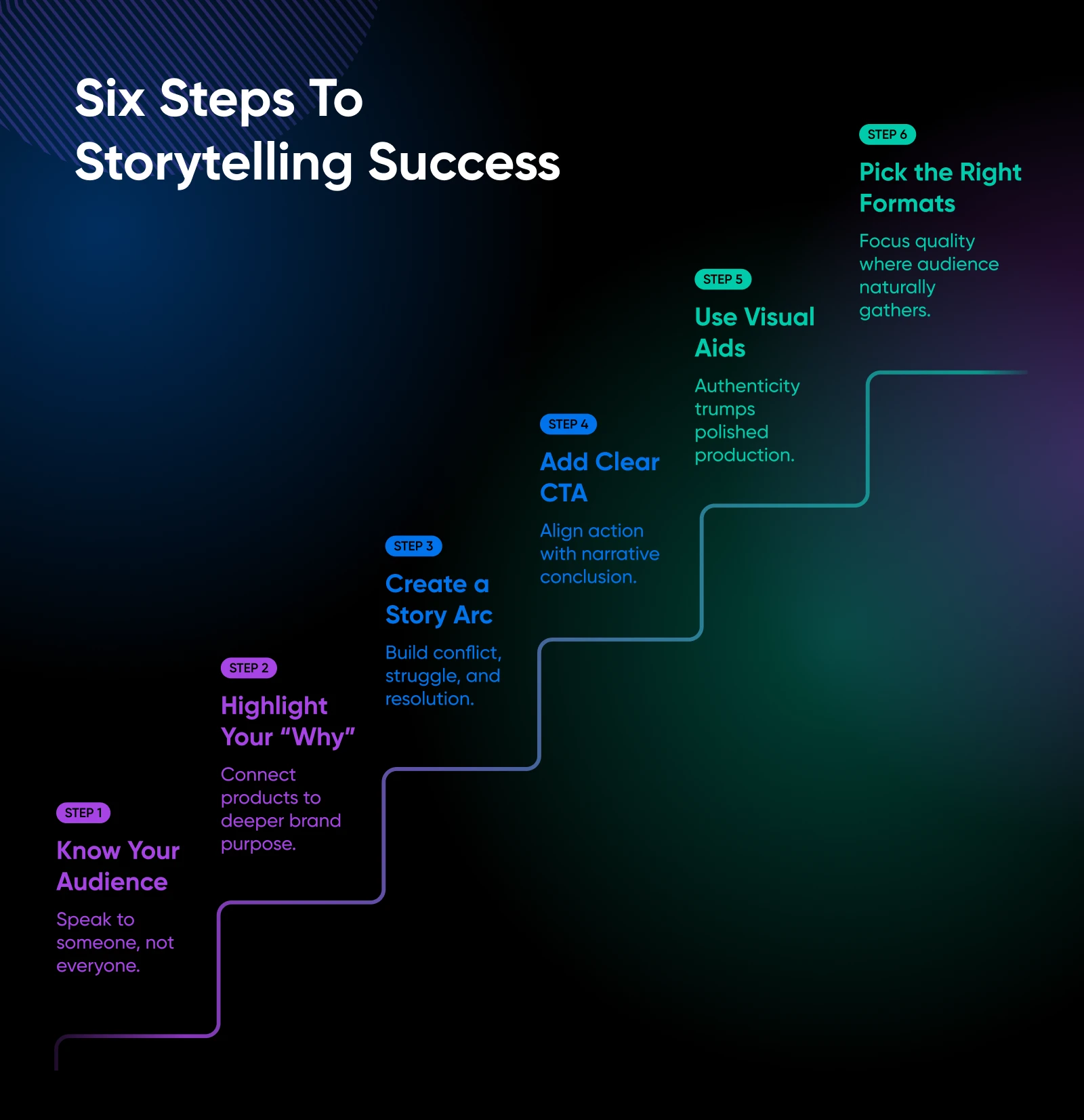The Power of Storytelling in Content Marketing

It happened to me: I was tapping through social media when I landed on a post that didn’t come from an account I followed.
I found myself pulled into a video: a relatable home cook loading sandwich supplies into a small bag and then depositing all of it into their toaster. Is anything more genius than that? In minutes, they had a perfectly toasted sandwich with gooey melted cheese and warmed up fixin’s…and the bag kept it all from dripping into the toaster and burning their house down!
Smash that “Add to Cart” button? You betcha.
Have you ever gotten so wrapped up in a brand’s story that you forgot they were even trying to sell you something? A memorable character, the right narrative, and a game-changing visual cue, and you can transform a simple promo into something that feels personal —or even magical.
That’s the power of storytelling in marketing, and it’s within any small business owner’s reach, even if you’re a team of one with zero Hollywood connections.
In this article, we’ll explore how you can harness storytelling to captivate audiences, strengthen brand loyalty, and boost sales.
We’ll talk about the psychology of why storytelling worksand examine what makes a marketing story truly resonate, plus share actionable steps to bring your brand’s story to life. Ready to spark some emotional connections and set your content apart from a sea of “meh” marketing messages?
What Is Storytelling Marketing?
Picture the earliest campfires, where people gathered under the stars to share tales of adventure, triumph, and caution. Fast-forward to your modern smartphone screen, and the core principle remains: humans connect through stories. Storytelling marketing uses the same timeless narrative techniques to frame your product or service in a way that’s engaging, memorable, and meaningful.
Instead of dry bullet points or sales copy, you craft a narrative that appeals to emotion, identity, or curiosity. Your customer’s challenge becomes the story’s conflict, while your product guides them toward a resolution.
When done well, storytelling marketing resonates on a deeper level than any generic, one-size-fits-all ad. And for small business owners, that’s often the key to standing out in a crowded market.
Why Is Storytelling Important in Marketing?

You’ve likely heard the phrase “facts tell, stories sell.” But why exactly does a story grab our attention and persuade us to take action? Let’s break it down.
- It improves the buying experience: Stories help potential customers envision themselves using (and loving) your product or service. They replace the dryness of specs and bullet points with a mini-journey that customers can see themselves embarking on.
- It creates emotional connections: People buy with their emotions first, then justify with logic. Whether it’s pride, nostalgia, hope, or empathy, a good story taps into these feelings. Share real-world anecdotes, customer success stories, or even behind-the-scenes struggles to show that your brand is powered by humans — and that’s appealing on a primal level.
- It builds trust and credibility: Being transparent about your ups and downs builds rapport. Customers want to trust you before they hand over their money, so letting them see your brand’s genuine story can accelerate that bond.
- It makes your brand more memorable: In a sea of similar products, a brand with a compelling narrative can linger in someone’s mind for days or weeks. That mental footprint might be the difference between a one-time browser and a lifelong customer.
- It showcases your brand’s purpose: Whether you champion sustainability, support local communities, or have a greater social mission, weaving that into your storytelling helps people feel like they’re part of something bigger than just a transaction.
- It humanizes your brand without sounding sales-y: We’ve all cringed at in-your-face sales language. Storytelling softens that pitch, shifting the focus from “buy now” to “let’s solve this problem together,” and that feels far more genuine.
What Makes a Good Marketing Story?

Most great stories — from classic fairy tales to modern-day brand campaigns — share common elements. Here’s how those elements translate to marketing your business:
A Relatable Protagonist
Every narrative needs a hero. In marketing, that hero could be your customer, your founder, or even your brand persona. The key is relatability. If readers see themselves in the story’s protagonist, they’ll be more invested. For example, if you sell eco-friendly cleaning products, your protagonist might be a busy parent who wants a spotless home without exposing the family to harsh chemicals.
Persona
In marketing, “persona” refers to a fictional customer that reflects your primary audience (or one of them). Businesses develop personas to understand better who they’re marketing to and how to sell to them.
Read More
The more you align your main character’s struggles, goals, or emotions with those of your audience, the stronger the bond. People will think, “Hey, that’s me!” and that identification can be a game-changer.
An Emotional Connection
In the same way a great novel pulls at your heartstrings or makes you laugh out loud, effective marketing stories make people feel something. Are you describing how your entrepreneurial journey led you to quit a dead-end job and follow your passion? Or how a customer’s life changed after using your service?
Pinpoint the emotion you want your audience to feel (like excitement, relief, or hope) and craft your content around evoking that sensation. Emotional resonance often beats logical arguments alone.
A Plot
Even the best concept can fall flat if it’s buried in tangents or drags on endlessly. Keep the story tight, focused, and momentum-driven. Present a clear conflict or challenge, escalate it, and then deliver a resolution that aligns with your brand offering.
Remember, you’re not writing a 300-page novel. Remember high school English class? Keep it simple with:
- A beginning to introduce the challenge.
- A middle to highlight the struggle or process.
- An end to reveal the solution (your product, service, or idea).
Facts and Figures To Support Your Message
Stories are powerful, but your audience might still crave a dash of logic to justify their emotional excitement. That’s where data or testimonials come in. For example, if you claim your new mattress helps people sleep better, share quick stats from a user poll or mention that 96% of buyers reported feeling more rested.
A short, compelling statistic or testimonial can anchor your narrative. It doesn’t have to be huge — even a single well-placed fact can add credibility.
Authenticity
Nothing kills a story faster than feeling forced or fake. If your brand story reads like a formulaic ad, people will scroll away fast. Instead, let your personality, voice, and real experiences shine through, even if that means admitting you’ve faced hiccups or failures.
Honesty about challenges (like shipping delays during your first product launch) shows readers you’re human. In an era dominated by AI-generated content, genuine authenticity can be your secret sauce.
How To Tell a Good Content Marketing Story in 6 Steps

So you’re ready to craft stories that resonate, but how do you get started? These steps will help you plan, create, and share a narrative that hits home without overwhelming your schedule.
Step 1: Get To Know Your Target Audience
If you’re speaking to everyone, you’re truly speaking to no one. Instead, pinpoint the people who are most likely to love what you do. Survey your email list, run quick polls on social media, or simply observe who your existing customers are.
First step to take: Write a one-paragraph “audience profile” describing your ideal reader’s dreams, fears, and day-to-day challenges.
Step 2: Connect Your Product To a Larger Purpose or Goal
No matter how simple the product (even something like socks or coffee mugs) is, there’s usually a deeper reason behind why you make or sell it. Maybe you care about sustainability, supporting local artisans, or giving people a moment of zen in their hectic day. Highlight that “why” in your story.
First step to take: Brainstorm one sentence that describes your brand’s ultimate mission or purpose. Keep it front and center when writing your story.
Step 3: Create a Cohesive Narrative Arc
Every piece of content — from a blog post to an Instagram Reel — should feel like part of the same overarching story. That means consistency in tone, theme, and messaging. If you share an origin story on your About page, tie the next social media post back to that same theme.
First step to take: Jot down a basic outline: conflict → struggle → breakthrough → resolution. Then decide which piece of content will cover each phase.
Step 4: Use a Clear Call to Action (CTA)
Even the best story should nudge people toward taking the next step, whether it’s subscribing to your newsletter or trying your product. Align your CTA with the resolution of the story you’re telling.
First step to take: Decide what action you want customers to take when they engage with your brand’s story, whether that’s signing up for a newsletter or starting a free trial.
Step 5: Include Visual Aids
Photos, short videos, or even hand-drawn doodles can amplify your story. You don’t need big-budget visuals. Authenticity is usually more interesting than polish. Use behind-the-scenes shots, user-generated content, or quick before-and-after images to anchor your narrative.
First step to take: Explore free, beginner-friendly tools like Canva that can help you craft appealing visuals in minutes. Don’t overthink it; a genuine snapshot is sometimes more powerful than a fancy staged photo.
Step 6: Choose Content Formats Wisely
Rather than plastering the same story on 10 social platforms, pick one or two channels that align best with your audience. Maybe your audience loves Instagram Reels, or perhaps they prefer reading longer blog posts on your website. Focus on quality over quantity.
First step to take: Ask yourself, “Where does my audience hang out?” Then, commit to consistently sharing your story there. You can always expand later.
Where To Deploy Your Story (Without Overwhelm)
Stories can live anywhere, but you don’t have to be everywhere. Here are a few key places to share your narrative without losing your mind.
- Your website’s “About” page: This is ground zero for telling your brand story. Let visitors discover how you got started, what fuels your passion, and why you’re different.
- Social media: Platforms like TikTok or Instagram are perfect for micro-stories. Post a quick behind-the-scenes clip of your packaging process or a short testimonial from a happy customer to show your audience the real you.
- Email marketing campaigns: Turn your story into a serialized email series. Each email can cover a different piece of the puzzle: your brand origin, a customer success story, a behind-the-scenes look, and so on.
- Blog series: If you enjoy writing, consider a multi-part blog narrative. One post can outline the problem, the next dives into the journey, and the last post offers the resolution (plus a CTA to buy or subscribe).
Whichever channels you choose, keep in mind that a single story can (and should!) be repurposed. A blog post can become short social media snippets, which can become talking points in an email newsletter. This approach helps you maximize your time while keeping your message consistent across different channels.
“Boring” Brands That Tell Great Stories
You don’t have to be a luxury carmaker or cutting-edge tech startup to create memorable campaigns. These examples prove everyday products can still capture hearts with smart storytelling.
IKEA: “The Wonderful Everyday”
IKEA turned the mundane job of furniture shopping into an experience about transforming simple living spaces into cozy homes. Their ads frequently showcase relatable, everyday moments — from families building a kid’s bedroom to roommates assembling bookshelves at midnight. These mini-stories resonate because they’re real-life glimpses into the journey of homeownership or apartment living.
Instead of highlighting products with sterile catalogs, IKEA injects humor, warmth, and the promise of a more comfortable life. You can do the same by focusing on how your product fits into your customers’ daily lives.
Dove: Real Beauty
A soap brand might seem as “ordinary” as it gets, but Dove broke the mold by shining a light on real women; and the things that make all of them uniquely beautiful. The “Real Beauty” campaign championed authenticity and self-esteem, and it tugged on viewers’ heartstrings, prompting discussion and fostering loyalty.
By focusing on genuine stories and touching on a universal challenge (self-confidence, in this case), Dove became more than just soap. Ask yourself what bigger cultural or personal conversation your product can tap into.
Bring Your Brand Story to Life With DreamHost
Storytelling marketing bridges the gap between product features and real human emotion, turning an everyday transaction into a shared experience.
At DreamHost, we believe that every small business has a story worth telling. We’re here to help you share your narrative with the world. If you’re ready to transform your content marketing with storytelling, check out our hosting solutions. Together, we’ll make sure your story reaches the people who need to hear it most with affordable, reliable WordPress hosting and award-winning customer service.
Unleash your creativity, show the human side of your brand, and watch how stories can spark genuine connections. Because at the end of the day, a powerful story beats any sales pitch.



